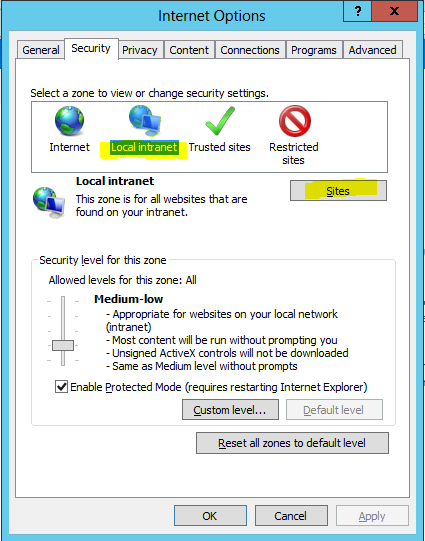I believe this issue is unique to non-domain environments
I am trying to install SPF 2013 RTM in the following environment:
- Windows Server 2012 RTM
- Stand-alone installation using SQL Server Standard
- Non-domain hyper-V instance (i.e. it is a workgroup)
- TFS Server (stand-alone installation)
Installation steps taken:
- Install software prerequisites. OK
- Install SharePoint Foundation bits. OK
- Run New-SPConfigrationDatabase. OK
- Run SharePoint 2013 Products Configuration Wizard. OK
After step 4 is completed, I am taken to the Central Administration Web site. I enter my credentials. I am presented with the following message "Sorry, this site hasn't been shared with you"
Page requested:
h ttp://tfs01:1841/_admin/adminconfigintro.aspx?scenarioid=adminconfig&welcomestringid=farmconfigurationwizard_welcome
Redirected to the following page:
h ttp://tfs01:1841/_layouts/15/AccessDenied.aspx?Source=http%3A%2F%tfs01%3A1841%2F%5Fadmin%2Fadminconfigintro%2Easpx%3Fscenarioid%3Dadminconfig%26welcomestringid%3Dfarmconfigurationwizard%5Fwelcome
Looking at the SP ULS logs, I see the following exception:
Unexpected Exception in SPDistributedCachePointerWrapper::InitializeDataCacheFactory for usage 'DistributedViewStateCache' - Exception 'Microsoft.ApplicationServer.Caching.DataCacheException: ErrorCode:SubStatus:There is a temporary failure. Please retry later. (One or more specified cache servers are unavailable, which could be caused by busy network or servers. For on-premises cache clusters, also verify the following conditions. Ensure that security permission has been granted for this client account, and check that the AppFabric Caching Service is allowed through the firewall on all cache hosts. Also the MaxBufferSize on the server must be greater than or equal to the serialized object size sent from the client.) ---> System.ServiceModel.EndpointNotFoundException: Could not connect to net.tcp://tfs01:22233/. The connection attempt lasted for a time span of 00:00:00. TCP error code 10061: No connection could be made because the target machine actively refused it [2001:0:9d38:953c:c01:1617:f523:f0f0]:22233. ---> System.Net.Sockets.SocketException: No connection could be made because the target machine actively refused it [2001:0:9d38:953c:c01:1617:f523:f0f0]:22233 at System.Net.Sockets.Socket.DoConnect(EndPoint endPointSnapshot, SocketAddress socketAddress) at System.Net.Sockets.Socket.Connect(EndPoint remoteEP)
at System.ServiceModel.Channels.SocketConnectionInitiator.Connect(Uri uri, TimeSpan timeout) -
-- End of inner exception stack trace --- Server stack trace:at System.ServiceModel.Channels.SocketConnectionInitiator.Connect(Uri uri, TimeSpan timeout) at System.ServiceModel.Channels.BufferedConnectionInitiator.Connect(Uri uri, TimeSpan timeout) at System.ServiceModel.Channels.ConnectionPoolHelper.EstablishConnection(TimeSpan timeout) at System.ServiceModel.Channels.ClientFramingDuplexSessionChannel.OnOpen(TimeSpan timeout) at System.ServiceModel.Channels.CommunicationObject.Open(TimeSpan timeout)
at Microsoft.ApplicationServer.Caching.CacheResolverChannel.Open(TimeSpan timeout) at System.Runtime.Remoting.Messaging.StackBuilderSink._PrivateProcessMessage(IntPtr md, Object[] args, Object server, Object[]& outArgs) at System.Runtime.Remoting.Messaging.StackBuilderSink.AsyncProcessMessage(IMessage msg, IMessageSink replySink) Exception rethrown at [0]:
at System.Runtime.Remoting.Proxies.RealProxy.EndInvokeHelper(Message reqMsg, Boolean bProxyCase) at System.Runtime.Remoting.Proxies.RemotingProxy.Invoke(Object NotUsed, MessageData& msgData) at Microsoft.ApplicationServer.Caching.CacheResolverChannel.OpenDelegate.EndInvoke(IAsyncResult result) at Microsoft.ApplicationServer.Caching.ChannelContainer.Opened(IAsyncResult ar) -
-- End of inner exception stack trace ---at Microsoft.ApplicationServer.Caching.DataCache.ThrowException(ResponseBody respBody, RequestBody reqBody) at Microsoft.ApplicationServer.Caching.DataCacheFactory.GetCacheProperties(RequestBody request, IClientChannel channel) at Microsoft.ApplicationServer.Caching.DataCacheFactory.GetCache(String cacheName) at Microsoft.SharePoint.DistributedCaching.SPDistributedCachePointerWrapper.InitializeDataCacheFactory()'.
An interesting point:
I am able to access central administration (h ttp://tfs01:1841/default.aspx) using the same credentials I used above. When I go to the Configuration Wizards, there is nothing I can do there. The account logged in shows as System Account.




